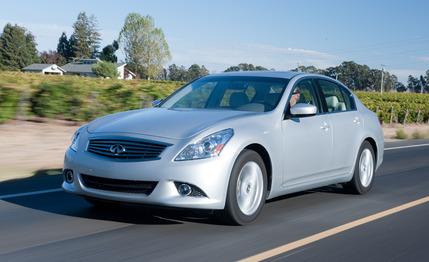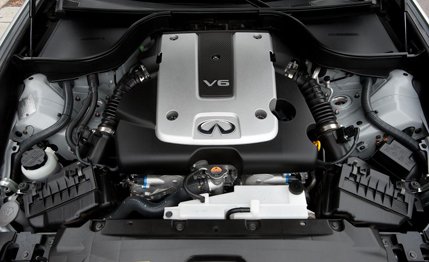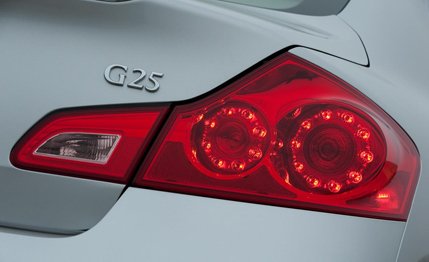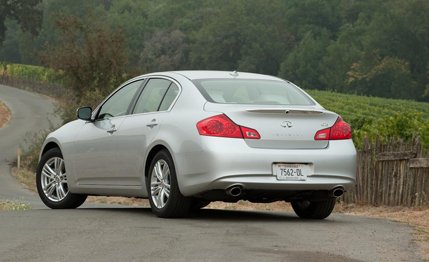 Short Take Road Test
Short Take Road Test

The climb to tougher CAFE standards starts in 2012, and Nissan’s Infiniti Division, like other carmakers, is making moves to stay on the right side of the mpg minimum—which accounts, in part, for this new addition to the G-series sedan lineup. Rear-drive G25s arrive with EPA ratings of 20 mpg city and 29 highway, modest improvements over the 19/27 ratings achieved by a G37 with the same seven-speed automatic—the only transmission offered on the G25. The all-wheel-drive G25x matches that rear-drive G37’s mpg but betters the all-wheel-drive 37’s 18/25 ratings.
The other element of the G25’s rationale is moola. Its base price of $32,275 is $4000 less than the starting price of the cheapest G37. The G25 Journey starts at $33,675, and the all-wheel-drive G25x, at $35,275. But more important, the G25 gives Infiniti a competitively priced entry versus arch-rival Lexus, whose IS line starts at $33,520. Thus, Infiniti’s marketing savants see a win-win: Infiniti benefits in CAFE scorekeeping and, it hopes, simultaneously expands market share for the G.
Small-Scale Six
The engine that’s at the core of this mission, the VQ25VHR, is new to the U.S. and unique here to the G-sedan lineup. It’s not new to Nissan, however; it has been a part of the Skyline inventory in Japan since 2007. (The G is known as the Nissan Skyline in Japan.)

At 2496 cc, it’s the smallest V-6 currently offered in North America. Infiniti’s official position for importing the little six is that it’s designed for longitudinal rear-drive applications and otherwise appropriate engines from Nissan’s North American inventory are intended for transverse mounting and front-wheel-drive mechanicals. Although diminutive, the 2.5 generates respectable output: 218 hp and 187 lb-ft of torque. It’s also quiet and, in partnership with the seven-speed automatic, exceptionally smooth.
Leisure Time
Even though the G25 is a little lighter than its G37 counterpart, giving away 110 hp and 82 lb-ft produces predictable results in the sprints: 0 to 60 mph in 7.3 seconds, almost two seconds slower than the G37, and a tenth or two slower than the last IS250 sedan we tested (in 2005). Those numbers reflect performance for a rear-drive G25 Journey, while the all-wheel-drive G25x we tested mustered its extra 200 pounds to 60 mph in 7.9 seconds and eventually covered the quarter-mile in 16 seconds flat at 89 mph.

But if stoplight-derby dominance isn’t a priority, the rest of the G25’s dynamic résumé is pretty appealing. Steering is accurate and tactile; transient response is brisk; the rear-drive G25’s braking performance—165 feet from 70 mph—is strong; and grip, delivered by a set of Goodyear Eagle RS-A all-season tires (225/55R-17 95V), was a pleasant surprise at 0.93 g. The G25x was stronger yet in our braking test, stopping in 159 feet from 70 mph, but it only managed 0.85 g on the skidpad.
With a respectable amount of standard content and decent road manners, the G25 stacks up as an attractive offering—well equipped, comfortable, and nice to look at. We’d like it a lot better if its powertrain inventory included a manual transmission option—or at least paddle shifters for the automatic—and the absence of a nav system option is a mystery in an entry-luxury car. But despite those reservations, the G25 looks like a good bet to achieve its mission in the marketplace.
